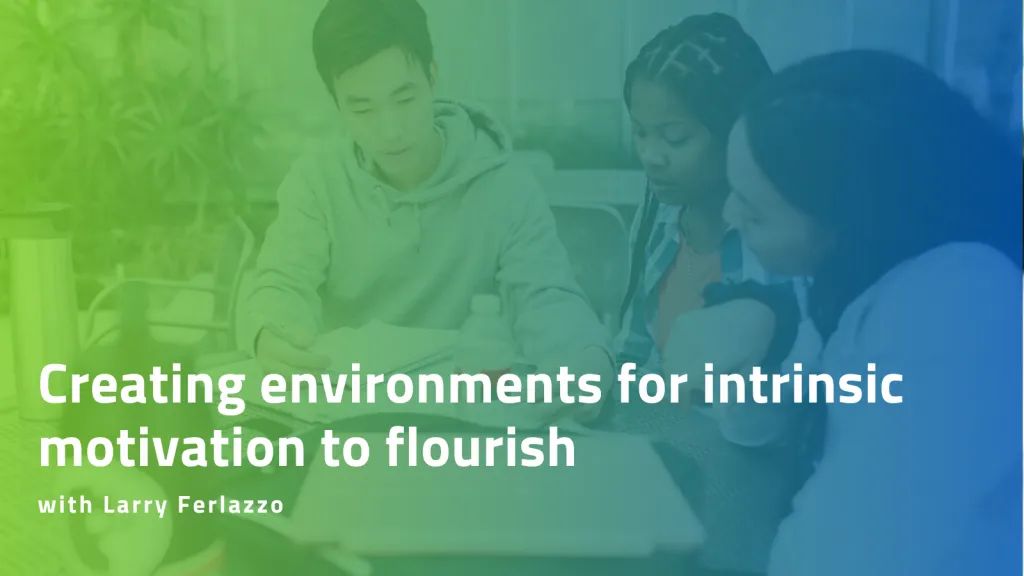Fostering intrinsic motivation


Fostering intrinsic motivation
Motivation is a fundamental element in education, driving students' engagement, persistence, and achievement. Both extrinsic and intrinsic forms can be beneficial. Extrinsic motivation, often driven by external incentives such as grades, rewards, or praise, can initially spark students' interest.
However, it is the intrinsic motivation, the inner drive and excitement for learning, that fuels long-term growth. When students are intrinsically motivated, they become active participants in their education, embrace challenges, seek out new knowledge, and derive a sense of fulfillment and accomplishment from their efforts.
By nurturing intrinsic motivation, educators create an environment that not only encourages academic success but also cultivates a lifelong love for learning. We met with Larry Ferlazzo, educator and author of the new publication The Student Motivation Handbook: 50 Ways to Boost an Intrinsic Desire to Learn, to discover more about creating conditions where intrinsic motivation can flourish.
Listen to the full episode on the Highest Aspirations podcast.
The four aspects of self-determination
Ferlazzo explains that according to self-determination theory, there are four primary conditions necessary to developing the highest forms of motivation:
- Autonomy (students tend to be more intrinsically motivated to learn if they have a role in deciding how it’s done),
- Relatedness (students are more engaged if the learning will bring them into relationship with people they like or respect),
- Competence (students should feel that they have the skills and support to do what they’re asked to do or that they can likely be successful), and
- Relevance (students should see the learning as relevant to their long term goals and hopes, and view it as fun or interesting to them)
With these key components in mind, we look more closely at how multilingual students are particularly impacted by certain conditions both in and outside of the classroom.
Ferlazzo notes that providing opportunities for autonomy is especially important for many ELs who may be struggling with situations that have been outside of their control.
“Especially for multilingual learners, especially for immigrant students who have come to the United States, generally have had little role in the decision to come here, and many are not thrilled about having to leave their homes. Autonomy is really important to these students because of the position these young people are often in,” Ferlazzo shares.
Another condition that is unique to the experience of multilingual learners is relevance. In many situations, ELL teachers may have an advantage of building intrinsic motivation based on the relevance of the learning to students’ long term goals, because for ELs in the US, learning English is relevant for almost anything they want to or will want to do in their lives.
“Whether it is ordering food at a restaurant or understanding what's going on in the movies to ultimately getting a job - it's like a gift that is offered to ELL teachers of relevance for their students.”
This does not mean that students will be automatically energized to learn without the presence of the other components, and educators still need to design learning experiences in a way that is fun and interesting to these students.
Further, while learning English is relevant for ELs to achieve all of their dreams, it is important to spend time learning about your individual students and what their hopes and goals for the future are so you can increase the relevance and help students see how their learning affects the possibilities they will have for their future.
Strategies for helping students feel more connected to their learning
With this increased appreciation for what is necessary to create conditions for intrinsic motivation to flourish, Ferlazzo shares a number of ideas for how we can implement these.

Finally, Ferlazzo emphasizes that we do not need to take an all or nothing mentality to the different types of motivation.
“We need to be comfortable with ambiguity, comfortable with sometimes things will work, sometimes they won’t. Maybe a particular class needs a little more extrinsic motivators than this particular class or this particular student, and that's okay. We just can't be dogmatic or ideological, we've got to base what we do on our experience and the students in front of us.”
Episode resources:
- Download the full episode transcript
- Visit his blog
- Read Ferlazzo's EdWeek column
- Finally, order his latest book on motivation